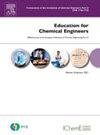优势、劣势、机会和威胁(SWOT)分析改进硕士化学与环境工程系教学
IF 2.3
2区 教育学
Q1 EDUCATION, SCIENTIFIC DISCIPLINES
引用次数: 0
摘要
大学教学必须不断进行评估,找出不足,提出改进措施,以避免学生缺乏动力,鼓励他们参与到学习过程中来。由于其复杂性,分析并不总是有效地进行。因此,本研究评估了SWOT分析在塞维利亚大学(美国)环境工程硕士(EEM)和化学工程硕士(CEM)教学中的应用。SWOT方法主要是找出不足,提出改进建议,并通过各种教学创新项目实施。确定了一些弱点,如初期适应过程困难、课业繁重和学习成绩差。我们设计了一套改善措施,并在电子商务管理和电子商务管理中加以应用。据观察,EEM和CEM的学习时间分别减少了0.85年和0.13年,同年发表硕士论文的学生人数增加了27% %。主要结果是学生满意度很高,在上次调查中为4.21/5.00,在跨学科、学习成果和学生/教授参与度等关键学习方面有了显著改善。本文章由计算机程序翻译,如有差异,请以英文原文为准。
Strengths, Weaknesses, Opportunities and Threats (SWOT) analysis to improve teaching of the chemical and environmental engineering department in master's studies
University teaching must be continuously evaluated to identify weaknesses and propose the improvement actions to avoid the lack of motivation by the students and to encouraged them to participate into the learning process. The analysis is not always carried out efficiently due to its complexity. For this reason, this study evaluates the application of a SWOT analysis in the teaching of the Environmental Engineering Master (EEM) and Chemical Engineering Master (CEM) at the University of Seville (US). The SWOT methodology consisted of identifying weaknesses and suggesting ways to improve, which were implemented through various teaching innovation projects. Several weaknesses were identified such as difficulties with the initial adaptation process, high academic workload and poor academic performance. A portfolio of improvement actions was designed and applied in the CEM and EEM. It was observed that the duration of studies decreased 0.85 and 0.13 years for EEM and CEM, respectively and that the number of students presenting their Master's theses in the same year of enrolment increased by 27 %. The main results were the high level of student satisfaction - 4.21/5.00 in the last survey and the significant improvement of key learning aspects such as interdisciplinarity, learning outcomes and student/professor engagement.
求助全文
通过发布文献求助,成功后即可免费获取论文全文。
去求助
来源期刊

Education for Chemical Engineers
Multiple-
CiteScore
8.80
自引率
17.90%
发文量
30
审稿时长
31 days
期刊介绍:
Education for Chemical Engineers was launched in 2006 with a remit to publisheducation research papers, resource reviews and teaching and learning notes. ECE is targeted at chemical engineering academics and educators, discussing the ongoingchanges and development in chemical engineering education. This international title publishes papers from around the world, creating a global network of chemical engineering academics. Papers demonstrating how educational research results can be applied to chemical engineering education are particularly welcome, as are the accounts of research work that brings new perspectives to established principles, highlighting unsolved problems or indicating direction for future research relevant to chemical engineering education. Core topic areas: -Assessment- Accreditation- Curriculum development and transformation- Design- Diversity- Distance education-- E-learning Entrepreneurship programs- Industry-academic linkages- Benchmarking- Lifelong learning- Multidisciplinary programs- Outreach from kindergarten to high school programs- Student recruitment and retention and transition programs- New technology- Problem-based learning- Social responsibility and professionalism- Teamwork- Web-based learning
 求助内容:
求助内容: 应助结果提醒方式:
应助结果提醒方式:


